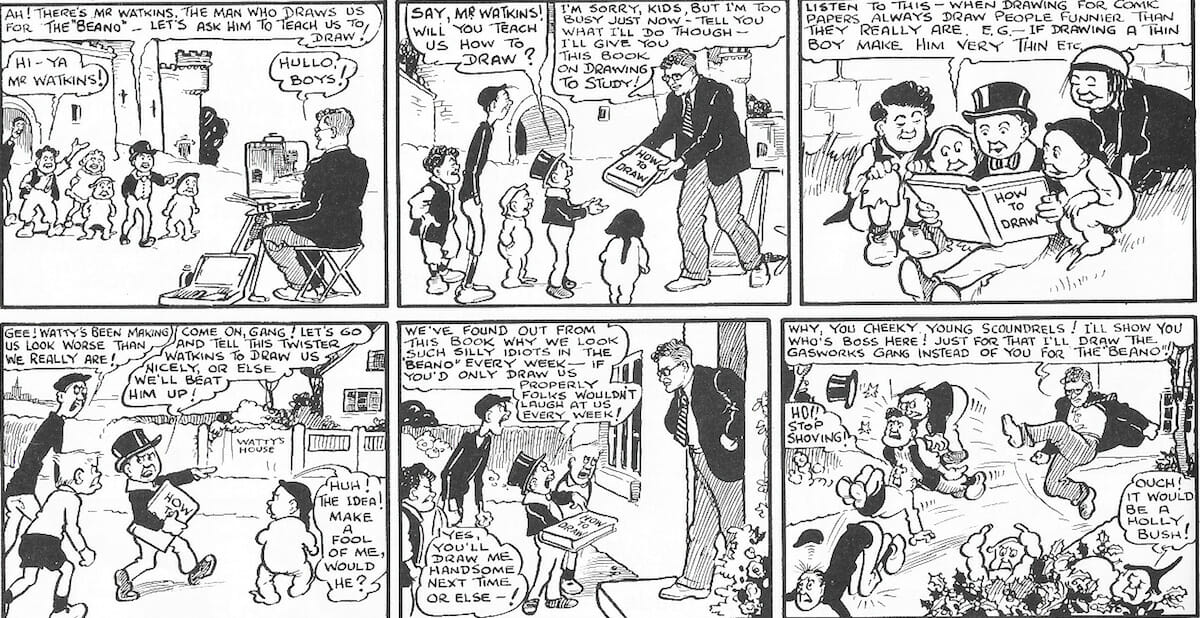When the second World War raged, brave people fought the Nazis in the air, on land, by sea, and also — more surprisingly — in childrens comics. It may not have been the most crucial or bloody of the many fronts when it came to taking down Hitler and his regime, but it’s undeniable that Dudley Dexter Watkins still needed balls of British steel to even try it.
Watkins was an English cartoonist, though he lived and worked in Scotland for most of his professional life. His signature works would all be done for DC Thomson: the venerable newspaper strips Oor Wullie and The Broons, the Dandy’s cowpie-guzzling strongman Desperate Dan, and the Beano’s Lord Snooty and His Chums. Unfortunately, while the newspaper strips do get collected, reading most of his comics work is difficult as DC Thomson doesn’t often believe in reprints. Luckily for this article, Lord Snooty did better than most and got a hardback collection of selected strips in 1998, The Legend of Lord Snooty.

Snooty, as many older readers remember him, stopped being a main character of the Beano back in 1991. When he shows up today, he’s a dopey rich fop, but as the Beano has established the current Dennis the Menace is the son of the 1980s Dennis and that a Lord Snooty was around 80 years ago, this must be a great-grandson. The original Earl Marmaduke of Bunkerton was a grand old-school Liberal, “son of a Duke but always pally with the beezer kids of Ash-Can Alley”.
Initially, he’d sneak out of the castle and disguise himself to hang out with the cool poor kids rather than the uncool upper class losers, though by the end of 1938 he’s just hanging around with them openly. (His chums were likely inspired by the Our Gang films, AKA The Little Rascals, as Watkins had been drawing their comics in the Dandy. All your favourite old comics are based on theft!)
When problems fell on his friends, he’d use his money, smarts, and/or comedic violence to sort it out, whether it was the local toughs, nasty PE teachers, or the mayor. And there’s almost certainly an article in how multiple strips are about Lord Snooty arranging slap-up feasts for his “street kid” pals, while not explicitly saying ‘they’re malnourished’. The fantasy for the readers is clear, that a rich toff is on their side.
Dan and Snooty helped kick off the Dandy and Beano respectively, but they weren’t the only such strips by Watkins. In 1939, his Peter Piper helped start the Magic – a mostly forgotten humour comic that was aimed at a younger audience. The combination of the Dandy, the Beano, and the Magic were the start of a grand plan by managing editor R.D. Low to create a ‘big five’ of comedy comics, just as he’d overseen a ‘big five’ of boys’ story papers.
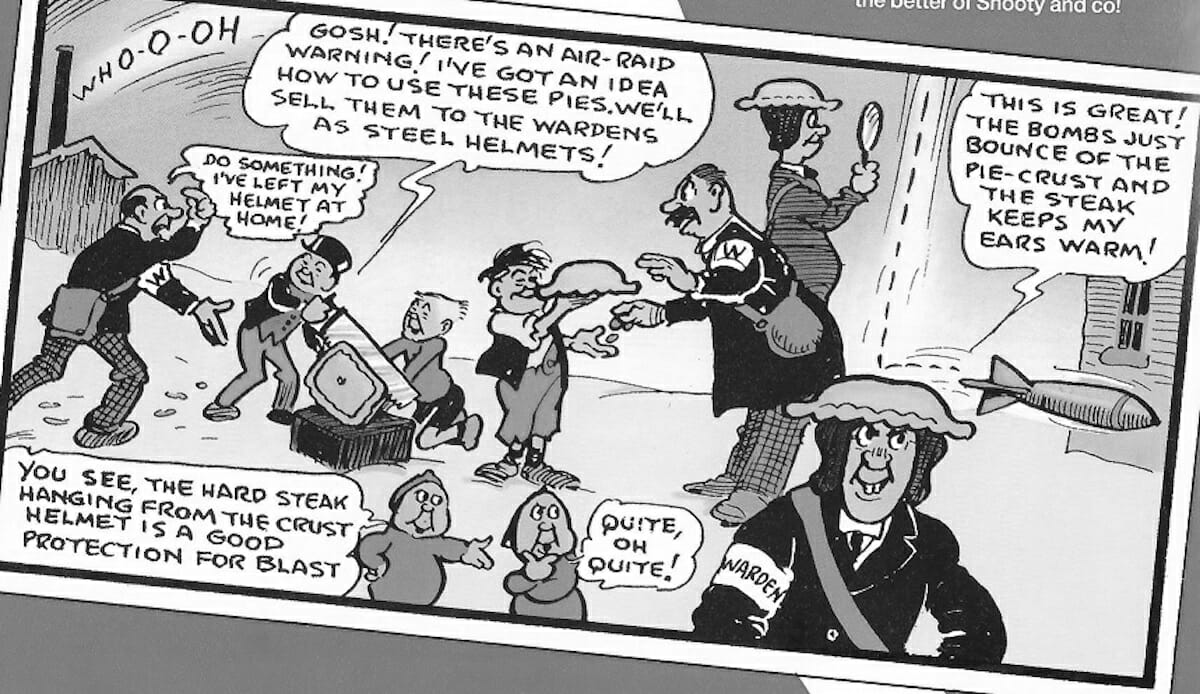
World War Two would end that plan– as well as the Magic– in the same way it would end the life of Magic’s editor, Bill Prowie, who was killed fighting in the Battle of Madagascar. Other DC Thomson staff, including Beano editor George Moonie, were called up or volunteered for combat as well, while the artists worked under threat of bombing and sandbags were placed around DC Thomson’s offices.
While Dudley Watkins remained on the home front (he would serve as a reserve constable), he decided his characters would be facing the Nazis with every bit of hilarious violence they could muster.
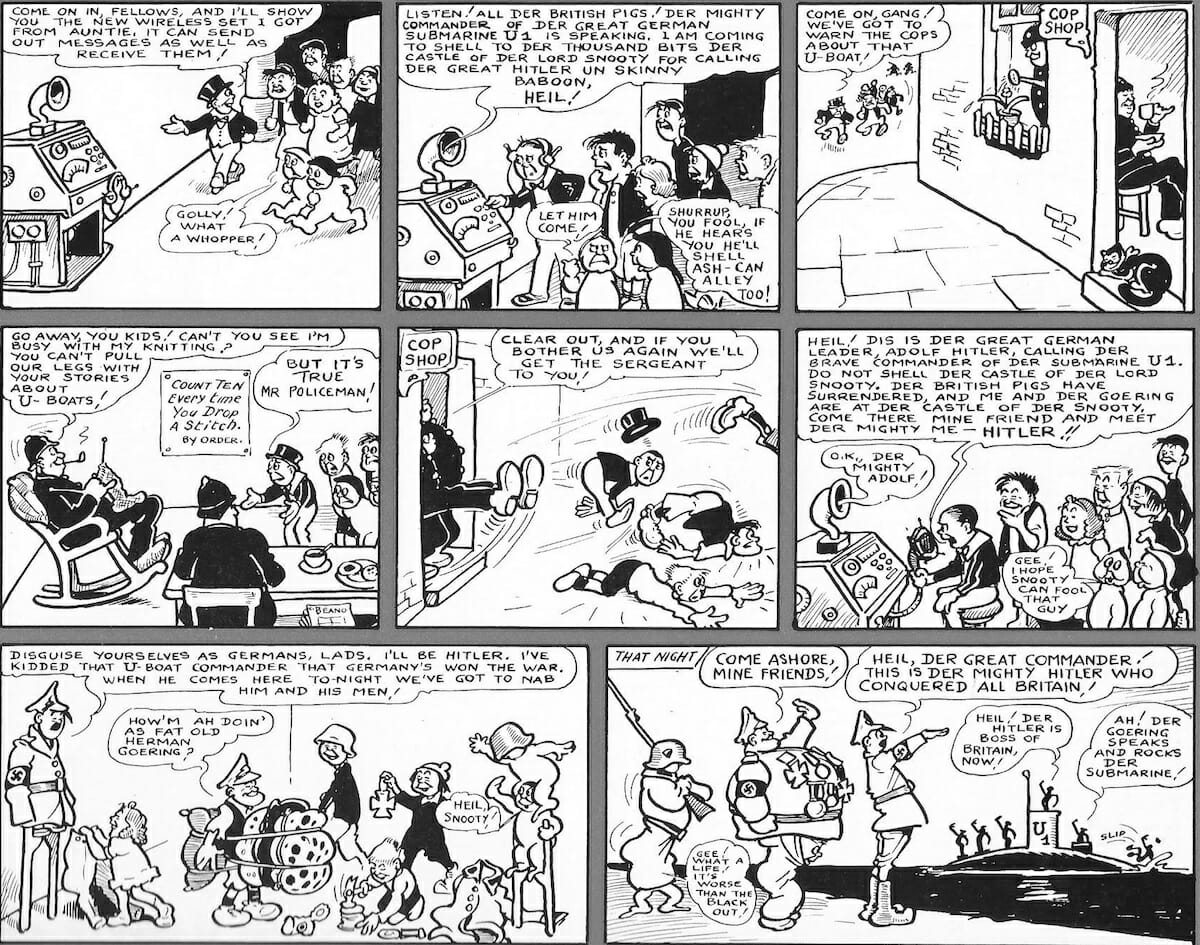
The first time the war appeared in the strip was on 6th January 1940, when Lord Snooty overhears a U-boat announcing they’re going to bombard his castle in revenge “for calling der great Hitler un skinny baboon”. When the police won’t listen, the kids disguise themselves as Hitler and Goering to trick the U-boat crew into thinking Germany has already won and march them to an army camp.
A strip on 2nd March has Snooty chumming around with the Royal Navy and their corking new destroyers, who agree to help the kids get their own back on the coppers who’ve nicked their football. And while not collected in Legend, a strip in April 1940 had a cackling Hitler tries to attack Britain with giant wasps and messes up Snooty’s football game.
You can see the running theme here. Hitler is a rotter, he’ll do bad stuff, but you don’t have to be too afraid of him, kids. We have to be prepared but it’ll be okay. Big wasps and a ruined football game are supervillain stuff, a world away from what’s happened in Poland and would start in Norway in April. Don’t worry about all that scary grown-up stuff, kids, Britain will win in the end.
And then the Battle of France takes place. And then France falls. And then Churchill warns the country: “I expect the Battle of Britain is about to begin.”
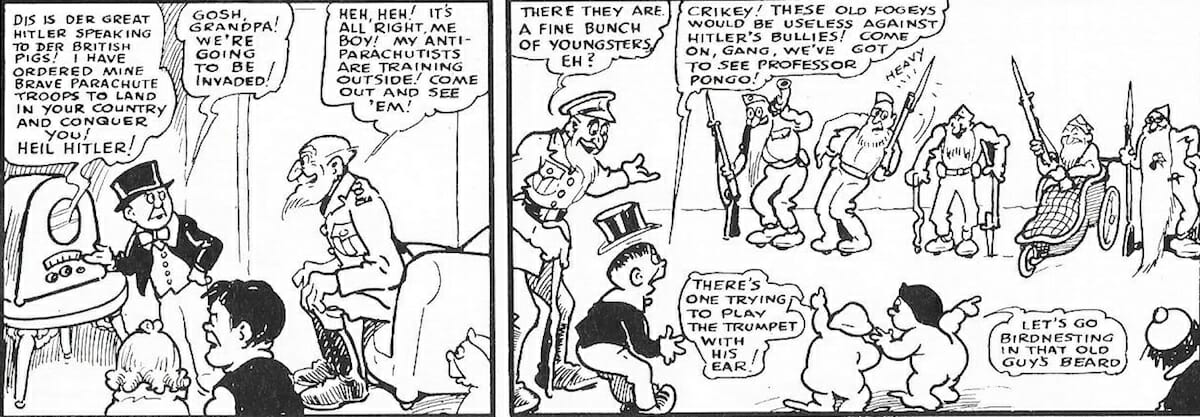
The strip from June 29th came out eleven days after Churchill’s speech, and for all we know was drawn right after hearing it. That strip opens with Hitler stating Germany’s going to invade with paratroopers: nothing fantastical this time. Parachute landings were a particular terror of the time, and something the Home Guard was on patrol for. A nod to the Home Guard even shows up with volunteer anti-parachutists, but unfortunately they’re Grandpa’s decrepit mates: “Crikey! These old fogies will be useless against Hitler’s bullies!”
(Years on, when Britain’s big cultural memory of the Home Guard are the lovable duffers from Dad’s Army, this bluntness is a surprise. But what else would kids think, and Watkins had to know they’d think, when they saw elderly volunteers on the march?)
Luckily, the Nazis are defeated because Snooty has giant moths eat their parachutes and the blighters land bum-first on every horned animal in the zoo (Snooty bought them). The police, now buddies, round the Germans up while Snooty chortles: “That’s what will happen to all the Nazis who try to land in Britain!”
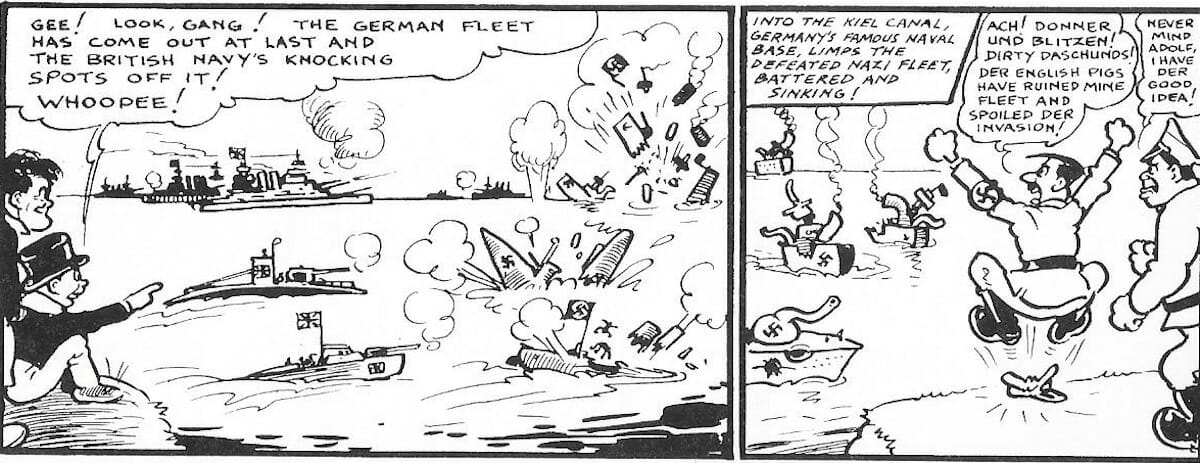
On 10th August, as war rages in the air, Snooty gets a personal letter from Hitler saying he’s going to bomb Bunkerton Castle because it’s better than his. (The lad’s grim reaction to this is a sight to see, the face of a boy thinking of getting his retaliation in first) Snooty sends the bombs back from “Good Old Britain” to “Rotten Old Germany” and blows Hitler’s castle up, then laughs about it: “Boy, our bombs sure bust it up!”
By October 19th, weeks into the Blitz, the infamous Operation Sea Lion is actually happening. As historians have predicted it would go, “the British Navy’s knocking the spot off [the Kriegsmarine]! Whoopee!” Hitler retaliates by making his soldiers so thirsty they’ll drink the sea, but Snooty saves Britain by, naturally, having sneezing elephants blow rain clouds into strategic positions. A few weeks after that, Hitler’s new castle had a notice on the roof: “Notice to RAF. This is Hitler’s palace – please don’t drop any bombs on me.”
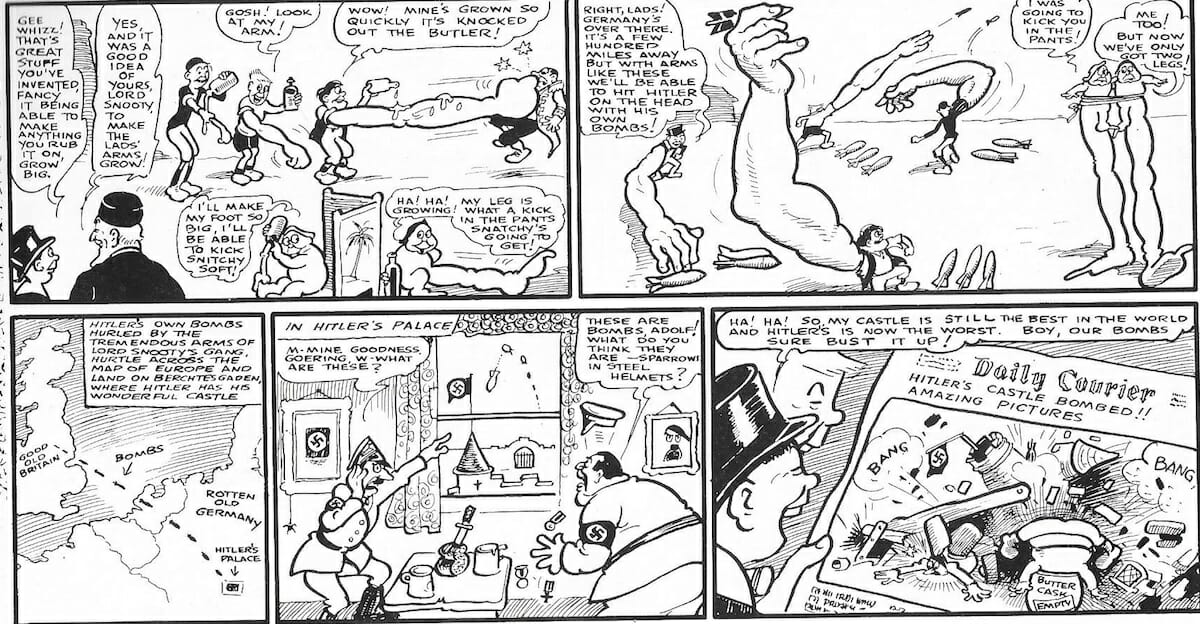
Underneath the old 30s comedy stylings – the caricatured art, the sight gags crammed into every panel, the blunt dialogue so every kid gets the joke – there’s a real sense of panic. The country is about to be bombed, now it’s being bombed, and the Beano’s audience may be homeless or evacuated. Everyone knows someone who’s dead or might die. It might be their dad or older brother. While Snooty’s actions in 1940 are often absurd and fantastic, the threat he’s facing is real. There’s no supervillains, no Red Skulls, this is the actual Wehrmacht and Luftwaffe coming to burn your home to the ground.
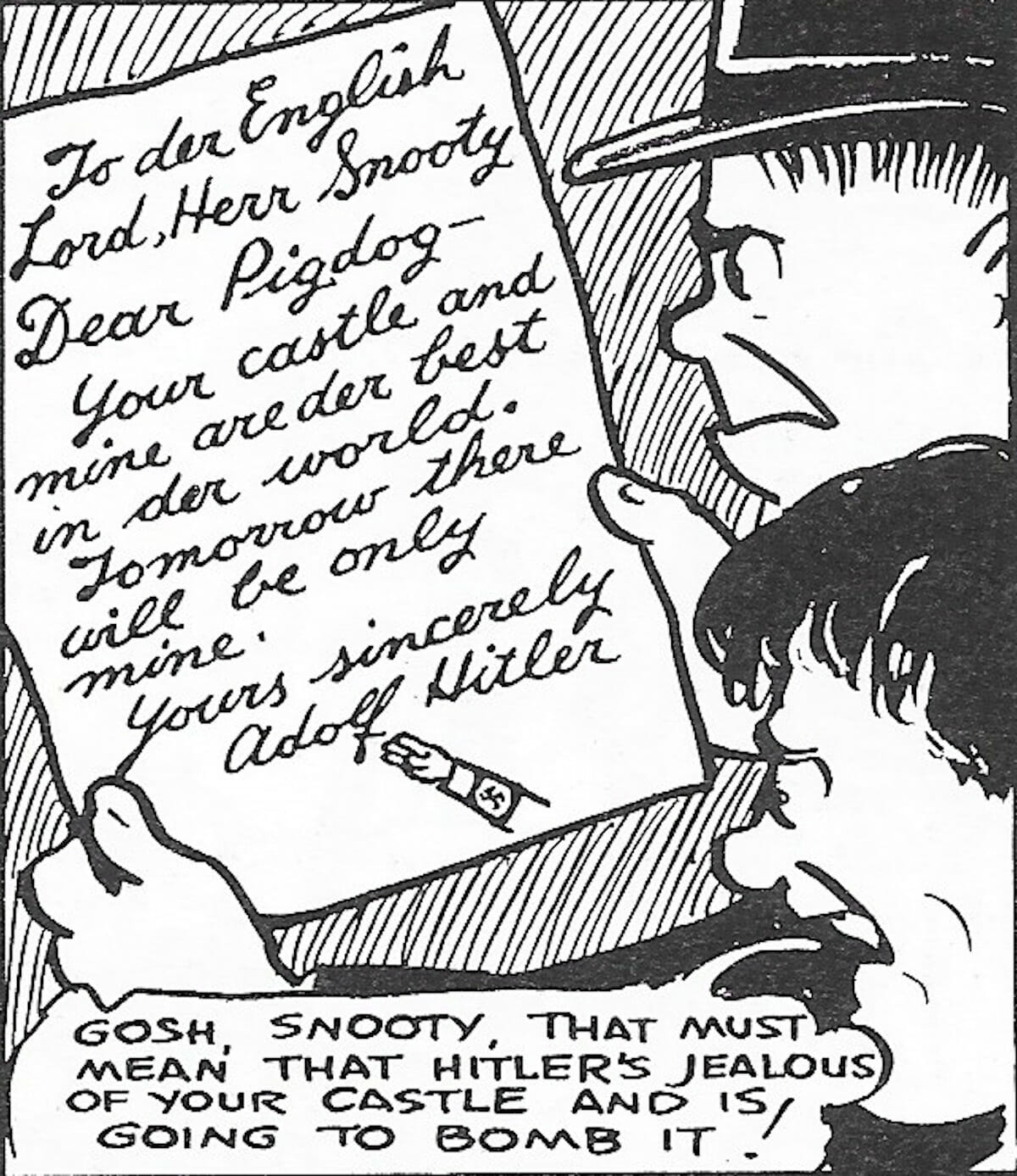
The June strip is the most desperate of all the 1940 strips. Most have a clear plot and punchlines that tie into the start of things. You might have giant germs attacking Berlin because Hitler’s pinched everyone’s butter rations, but Professor Pongo’s germs are set up at the start of the story. In contrast, June’s story is raw and sloppy. There is no cohesion. Stuff just happens, “and then they learned Professor Pongo had made big moths, and then the animals turned up, and then and then”, like Watkins was working in a feverish late-night rush to nail everything down as fast as he could.
Going back to the Churchill speech: “Upon this battle depends on the survival of Christian civilization… The whole fury and might of the enemy must very soon be turned on us. Hitler knows that he will have to break us on this island or lose the war. … All that we have known and cared for, will sink into the abyss of a new Dark Age.”
And after saying to keep calm earlier in the year, what’s Dudley Watkins saying to kids now?
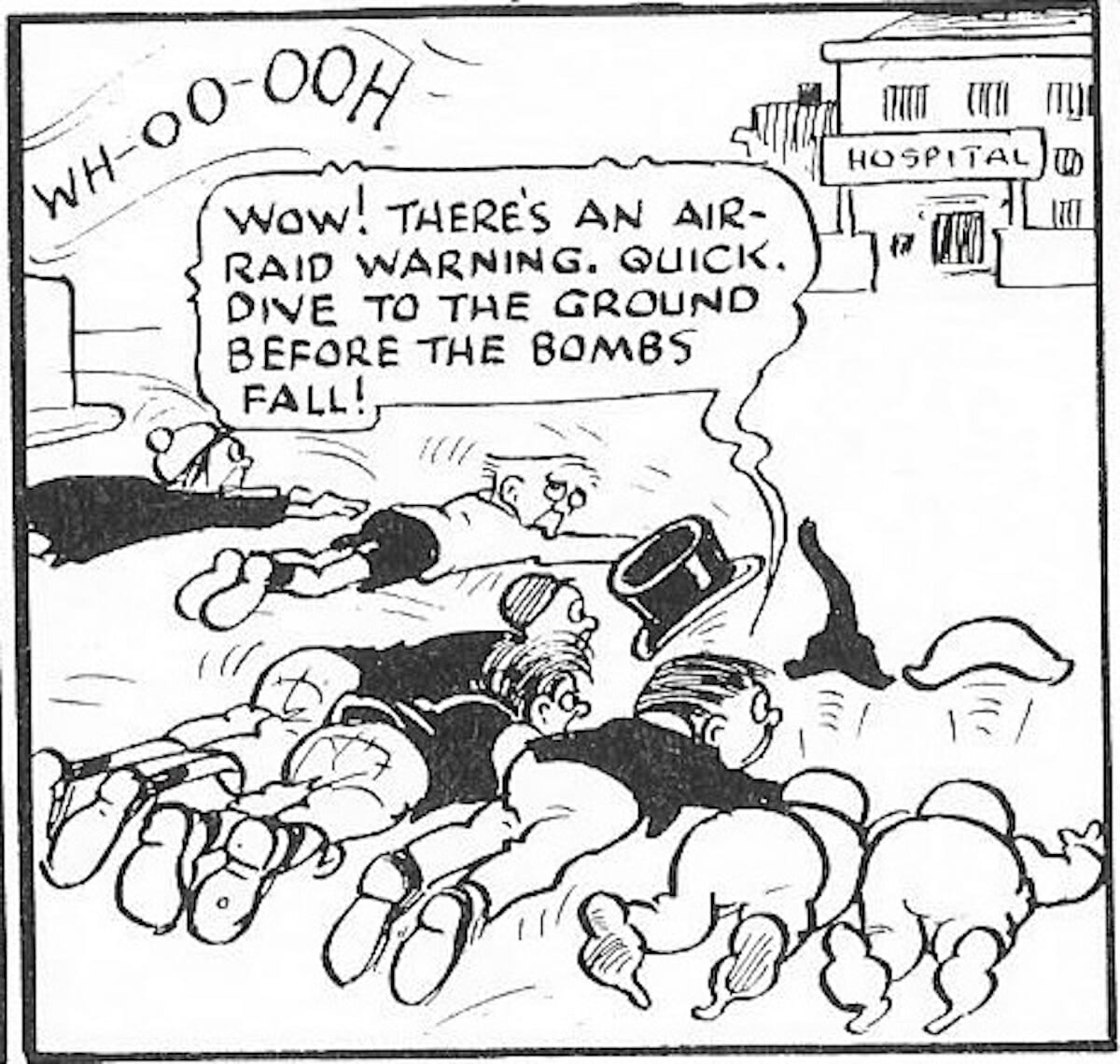
Well, at first, he’s saying the Germans are going to invade. Sorry kids, there’s nothing we can do about that, not when every other country has fallen. Don’t worry though: when they do show up, we’re going to beat the shit out of them. They are going to be hammered, kids, we’re going to hurt them. Later, when the threat of invasion seems a bit less inevitable, the message changes: okay, maybe the German navy will show up, but when they do, we’ll flatten them before they can land. We’re going to hold the line.
Crucially, during the Battle and the Blitz Watkins is also telling kids: we’ll get them back. There’s jokes that Britain is going to bomb Germany, that Hitler’s scared of our brave Bomber Command boys, that they’ll get theirs for what they’ve done to us. In that 19th October strip, you can see the silhouettes of bodies flying. Kids are often a bloodthirsty lot and in WW2, understandably, they wanted a lot of blood and they wanted vengeance. The East End and the Merseyside are ash, and you’re asking the kids of 1940s Britain for mercy? Request denied. Watkins gave them what they wanted.
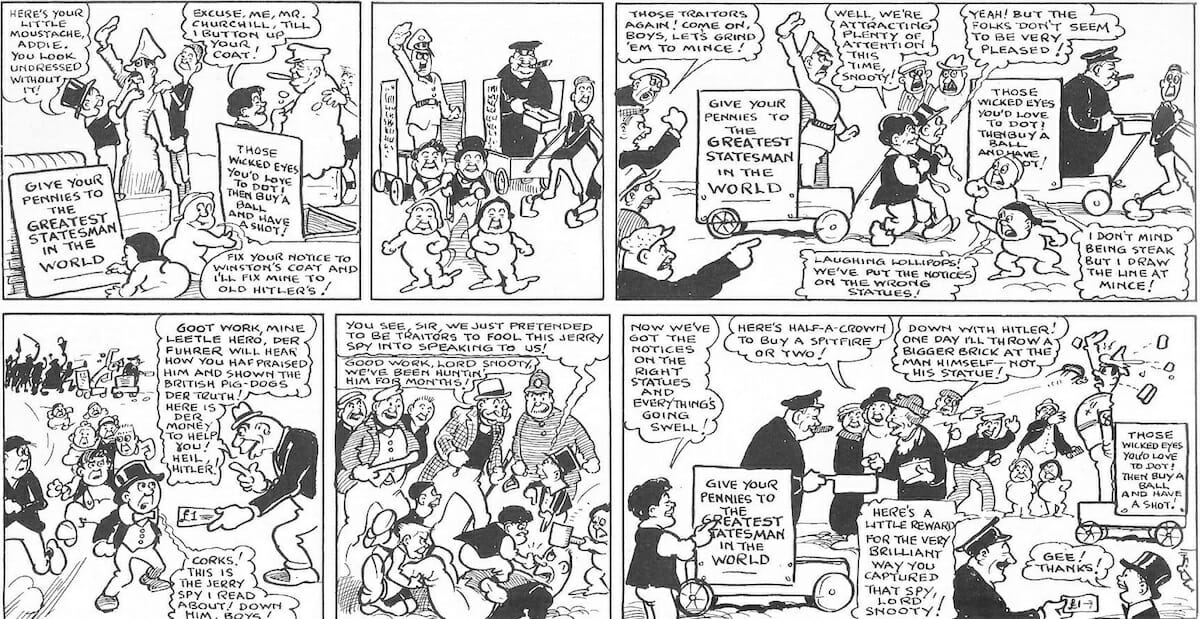
By 1941 onwards, the war’s just a thing happening in the regular strips. All the windows need replacing – because an air raid blew them out. (There’s a bunch of “and also an air raid happened” stories) Oh no, the gang’s errors have got them in trouble – by making them look like Nazi sympathizers. Snooty tries to help the old people when the buses are cancelled – because of petrol rationing. There’s even a PSA about keeping your gas mask handy. After a while, the war stops showing up even there (or at least in Legend).
You have to normalize things after a while. You have to keep the upper lip stiff and have a gallows humour. (Watkins’ colleague Eric Roberts wrote into work mentioning an incendiary had landed outside his house, and he wrote about it as a funny joke because he heard it land right as he drew “in the “CRUMP”” in a panel.) It’s just a thing that happens in the reader’s world, no longer a strange disruption but, like hunger, still a thing to defang with humour. Air raids are scary, kids, but the world goes on. Nobody likes the shortages, but we can find jolly japes to get around it. It’ll all be fine.

Luckily, it was fine. Thanks to Lord Snooty, Desperate Dan – and also the industrial & military efforts of the Allie – the war ended and Britain remained unconquered. Arguably the Nazis never had enough vessels to pull off an invasion anyway. But in 1940, people thought it was imminent.
There is an urban legend, summarised in the Beano: 80 Years of Fun special: “Intercepted wartime records of a planned German invasion stated that a number of prominent newspaper editors were to be captured and made answerable for the crime of ‘gross disrespect’. The Editor of The Beano was included among the names.” (Moonie, by the way, led an assault craft at D-Day) Another claim is that Watkins himself was on the List.
Now, none of that’s true. The ‘black book’ of targets, Sonderfahndungsliste G.B., can be found and read, and the blog Bear Alley did just that. Moonie isn’t on it, neither is Watkins, and DC Thomson isn’t either. It’s highly unlikely the Germans even knew what the Beano was.
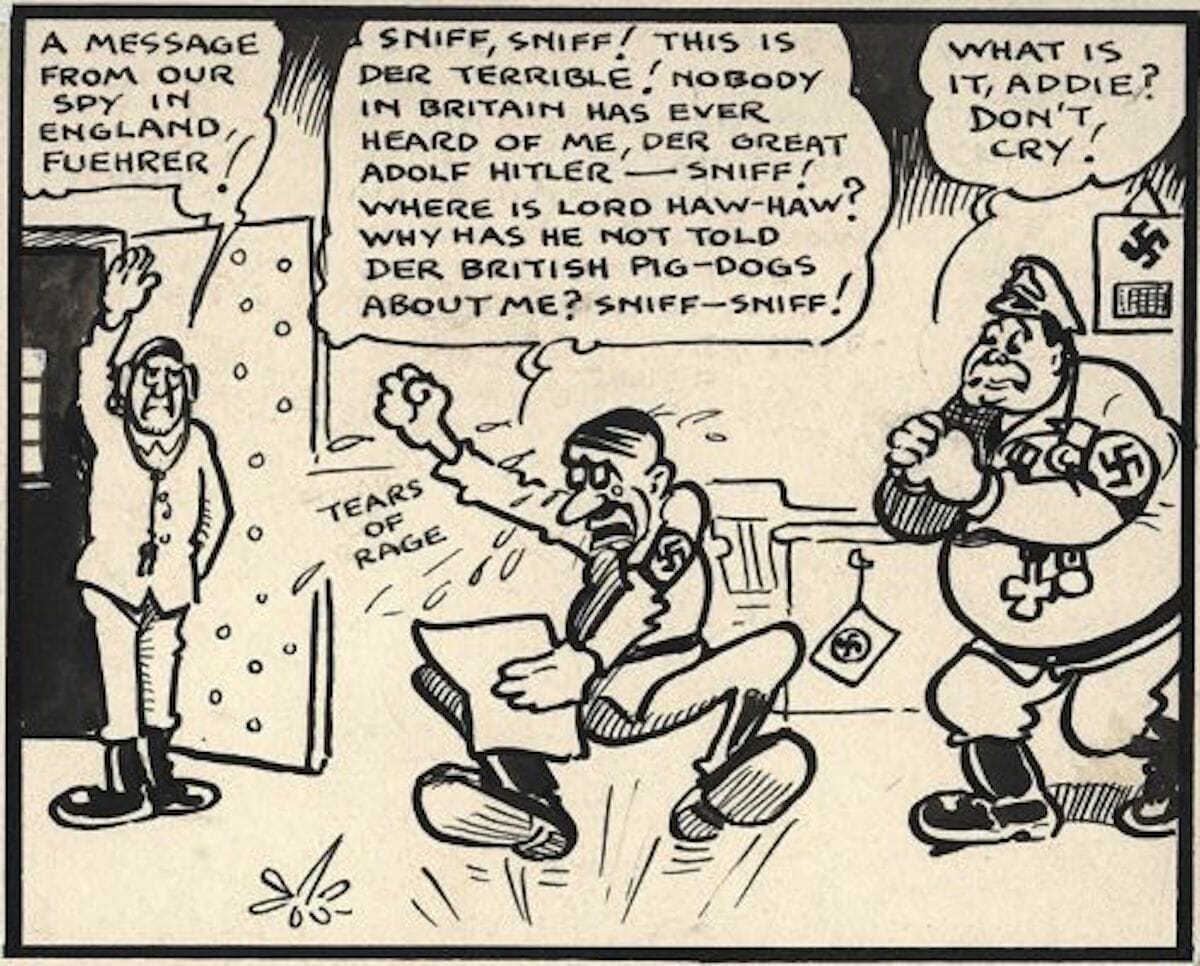
However, it’s not out of line to say that if the Nazis had invaded, they would have found out what the Beano was and been very unhappy. One cartoonist, the famous David Low, was marked out for Gestapo attention.
As British comics carried no credits then, potentially some artists could’ve escaped any punishment so long as someone at DC Thomson burned their records. Watkins, however, was credited for his artwork elsewhere and had a recognizable style. He even drew himself into a strip for 3rd January 1942, where he ended up in a feud with his own characters. It would not have been difficult for the Germans to learn Watkins has been calling der great Hitler un skinny baboon.
Churchill’s line about “the survival of Christian civilization” will seem over the top to us now; not just civilization, but specifically the Christian faith rests on us, but people at the time? They believed it. Watkins was a devout Christian, both in his private life and in his professional life, where he would do unpaid work for religious missions, and even painted a watercolour of the crucifixion for a preacher’s family.
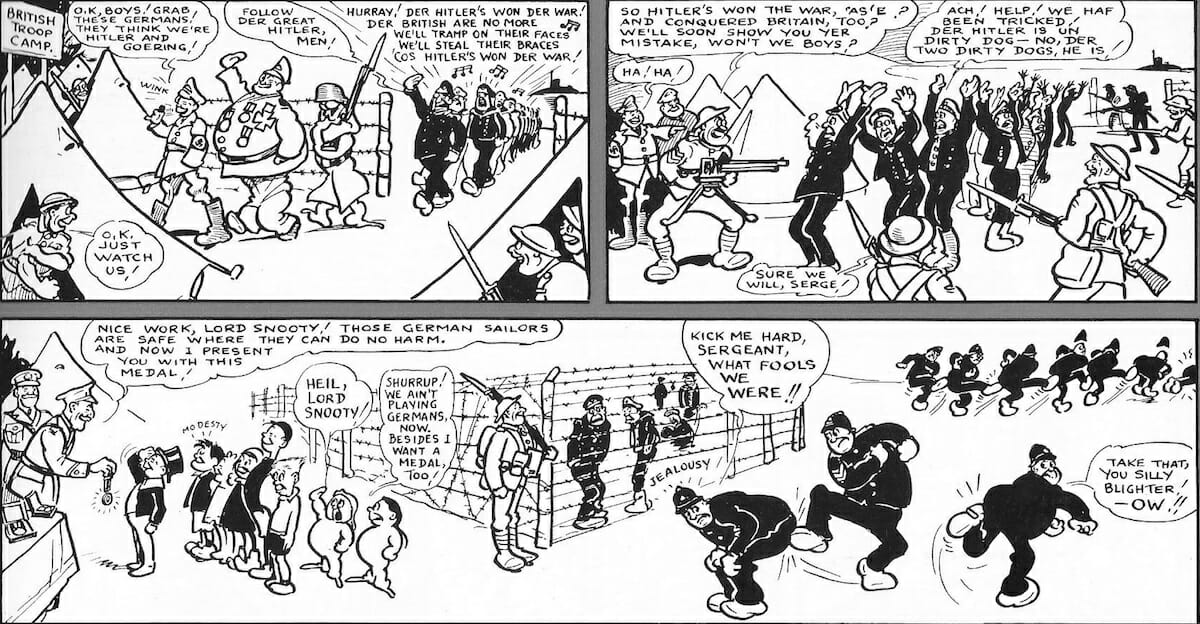
So, this very devout man hears that utter darkness and evil is coming to blight the Word of God and throw mankind into darkness, and this evil is coming to bomb British cities like it has in a dozen other lands. He has peers and co-workers picking up guns, but he’s not getting called up. All he has to fight with is his artwork, reassuring his audience of terrified children that it’s not all over. Good Old England can lick the Jerries, Hitler is just a whinging dope, and even with things burning around you there’s still light relief to be had.
However patriotic he was, he can’t have been certain in the dark sleepless hours that the Nazis would lose. Doing that when the Nazis might win and round you up? That takes guts. It takes balls of steel. In someone with Watkins’ faith, it takes the belief that this is your duty and the Lord’s calling.
It wasn’t necessary for the war effort for Watkins to put himself at risk, and unlike other DC Thomson men he’d had the chance to stay out of things; but he put himself at risk anyway. That should be part of his legacy as much as his comics, which sorely deserve reprinting.
